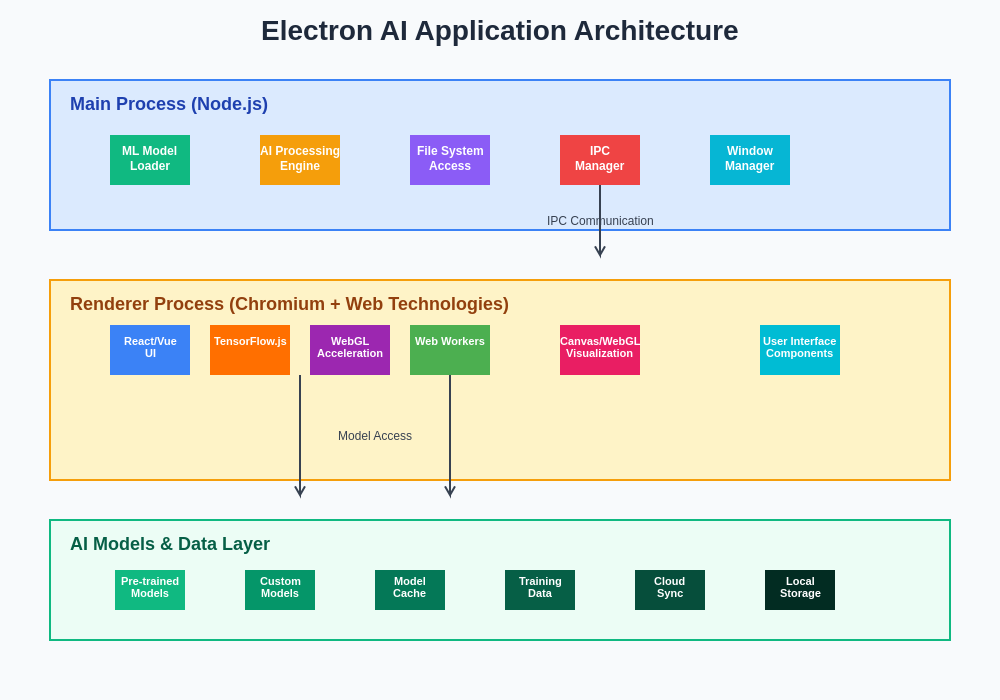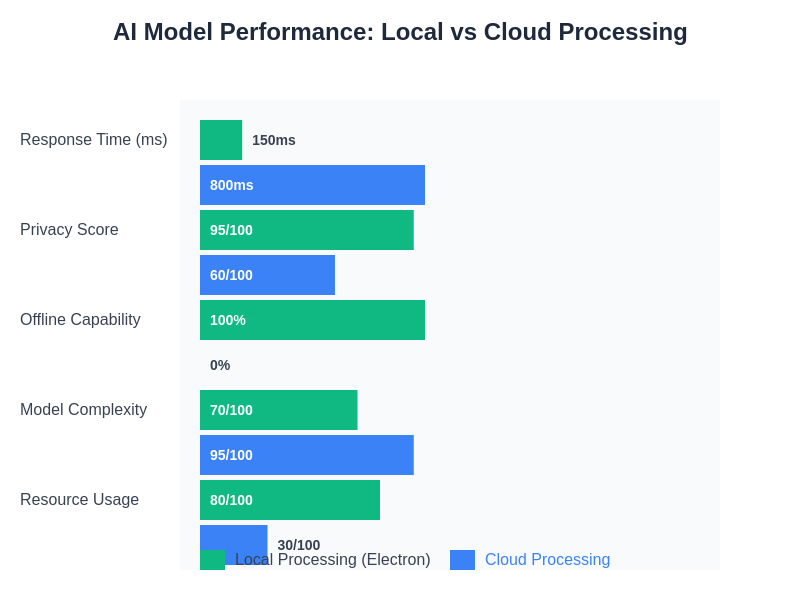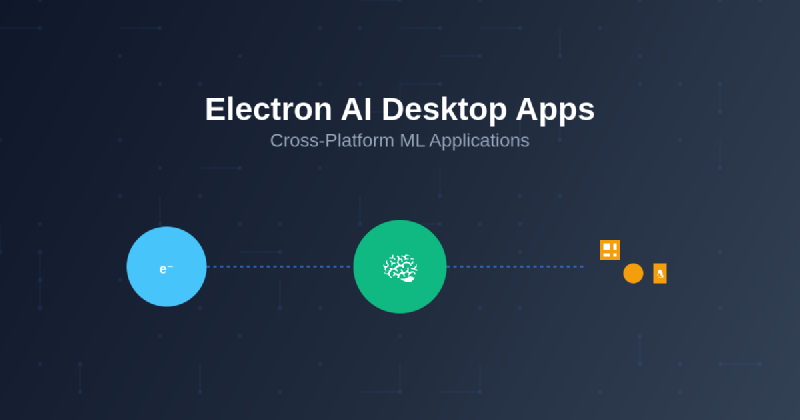The convergence of artificial intelligence capabilities with cross-platform desktop application development has opened unprecedented opportunities for creating sophisticated machine learning applications that operate seamlessly across Windows, macOS, and Linux environments. Electron, the powerful framework that enables developers to build desktop applications using web technologies, has emerged as a compelling platform for integrating AI and machine learning functionality into native desktop experiences that rival traditional applications while maintaining the flexibility and rapid development cycles associated with web-based technologies.
Explore the latest AI development trends to discover cutting-edge approaches and emerging technologies that are reshaping how developers integrate artificial intelligence into desktop applications. The evolution of Electron-based AI applications represents a fundamental shift toward democratizing machine learning capabilities by making them accessible through familiar web development paradigms while delivering the performance and user experience expectations of native desktop software.
The Foundation of Electron AI Applications
Building AI-powered desktop applications with Electron requires a comprehensive understanding of how machine learning models can be effectively integrated within the Electron architecture. The framework’s unique dual-process model, consisting of main processes and renderer processes, provides an ideal foundation for distributing AI workloads while maintaining responsive user interfaces and efficient resource management. This architectural approach enables developers to leverage the computational power of modern hardware while ensuring that machine learning operations do not interfere with the application’s core functionality or user interaction responsiveness.
The integration of AI capabilities into Electron applications involves careful consideration of model deployment strategies, data flow optimization, and performance management across different operating systems and hardware configurations. Developers must navigate the complexities of bundling machine learning models, managing dependencies, and ensuring consistent performance across diverse computing environments while maintaining the cross-platform compatibility that makes Electron an attractive choice for desktop application development.
Architecture Patterns for ML Integration
Successful Electron AI applications employ sophisticated architectural patterns that optimize the distribution of machine learning workloads between the main process and renderer processes. The main process typically handles model loading, initialization, and heavy computational tasks, while renderer processes focus on user interface updates and real-time feedback mechanisms. This separation ensures that machine learning operations can execute efficiently without blocking the user interface, creating smooth and responsive applications that maintain professional-grade user experiences even when processing complex AI tasks.
Advanced architectural patterns include the implementation of worker threads for isolating machine learning computations, message passing systems for coordinating between processes, and caching mechanisms that optimize model performance and reduce computational overhead. These patterns enable developers to create applications that can handle multiple concurrent AI operations while maintaining system stability and ensuring that resource consumption remains within acceptable limits across different hardware configurations and operating systems.
Experience advanced AI development with Claude to enhance your understanding of complex architectural patterns and implementation strategies for building robust cross-platform AI applications. The sophisticated reasoning capabilities of modern AI assistants can provide invaluable guidance for navigating the technical challenges associated with integrating machine learning models into desktop applications while maintaining optimal performance and user experience standards.
TensorFlow.js Integration Strategies
TensorFlow.js represents one of the most powerful and flexible options for integrating machine learning capabilities into Electron applications, providing comprehensive support for both pre-trained models and custom model development within JavaScript environments. The framework’s ability to execute models directly in JavaScript enables seamless integration with existing web technologies while providing access to hardware acceleration through WebGL and WebAssembly optimizations that significantly enhance performance for computationally intensive AI operations.
The integration process involves careful consideration of model format selection, optimization strategies, and deployment methodologies that ensure consistent performance across different platforms and hardware configurations. Developers can choose between various model formats including saved models, frozen graphs, and custom layer implementations, each offering distinct advantages for specific use cases and performance requirements. The flexibility of TensorFlow.js enables applications to support both cloud-based and offline AI processing, providing users with comprehensive functionality regardless of internet connectivity or privacy requirements.

The architectural complexity of Electron AI applications requires careful planning and implementation of data flow patterns that optimize performance while maintaining code maintainability and extensibility. The integration of TensorFlow.js models involves establishing efficient communication channels between different application components and implementing robust error handling mechanisms that ensure graceful degradation when AI operations encounter unexpected conditions or resource limitations.
Local Model Processing and Optimization
Local model processing represents a critical advantage of Electron AI applications, enabling users to perform machine learning tasks without relying on internet connectivity or external services that may raise privacy concerns or introduce latency issues. The implementation of local processing requires careful optimization of model size, memory usage, and computational efficiency to ensure that applications remain responsive and resource-efficient across different hardware configurations and operating system environments.
Optimization strategies include model quantization techniques that reduce memory footprint without significantly impacting accuracy, lazy loading mechanisms that minimize initial application startup time, and intelligent caching systems that store frequently used model components in memory for rapid access. These optimizations enable applications to deliver professional-grade AI functionality while maintaining the performance characteristics that users expect from native desktop applications.
The challenge of local processing extends beyond mere model execution to encompass comprehensive resource management strategies that balance computational performance with system stability and user experience quality. Developers must implement sophisticated monitoring and throttling mechanisms that prevent AI operations from overwhelming system resources while ensuring that machine learning tasks complete within acceptable timeframes and accuracy standards.
Cloud Integration and Hybrid Approaches
Modern Electron AI applications increasingly employ hybrid approaches that combine local processing capabilities with cloud-based AI services to deliver comprehensive functionality that adapts to varying network conditions, computational requirements, and user preferences. These hybrid architectures enable applications to leverage the speed and privacy advantages of local processing while accessing the advanced capabilities and computational power of cloud-based machine learning platforms when network connectivity and user preferences permit such integration.
The implementation of hybrid approaches requires sophisticated orchestration logic that can dynamically determine the optimal processing location based on factors including model complexity, data sensitivity, network availability, and performance requirements. Applications must implement robust fallback mechanisms that ensure continued functionality when cloud services are unavailable while providing seamless transitions between local and cloud processing modes that maintain consistent user experiences regardless of the underlying processing architecture.
Cloud integration strategies encompass various approaches including direct API integration with services such as Google Cloud AI, Amazon Web Services machine learning platforms, and Microsoft Azure Cognitive Services, as well as custom cloud deployments that provide specialized functionality tailored to specific application requirements. The flexibility of these approaches enables developers to create applications that scale effectively from individual users to enterprise deployments while maintaining consistent functionality and performance characteristics.
Enhance your research capabilities with Perplexity to stay informed about the latest developments in cloud AI services and integration methodologies that can enhance your Electron AI applications. The rapidly evolving landscape of cloud-based AI services provides numerous opportunities for enhancing application capabilities while maintaining optimal performance and user experience standards.
Performance Optimization Techniques
Performance optimization in Electron AI applications requires a multifaceted approach that addresses both the unique challenges of the Electron framework and the computational demands of machine learning operations. The dual-process architecture of Electron provides opportunities for distributing AI workloads effectively while also introducing complexity in terms of inter-process communication and resource management that must be carefully optimized to achieve optimal performance characteristics.
Key optimization techniques include the implementation of efficient memory management strategies that minimize garbage collection overhead, the use of web workers and child processes to isolate computationally intensive operations, and the application of caching mechanisms that reduce redundant model loading and inference operations. These optimizations work together to create applications that can handle complex AI tasks while maintaining the responsiveness and efficiency that users expect from desktop applications.
Advanced optimization approaches involve the integration of native modules that can leverage platform-specific optimizations and hardware acceleration capabilities, the implementation of progressive loading strategies that prioritize critical functionality while deferring less essential features, and the use of profiling tools that enable developers to identify and address performance bottlenecks in both AI processing pipelines and user interface components.
User Interface Design for AI Applications
The design of user interfaces for Electron AI applications presents unique challenges that stem from the need to communicate complex AI operations and results in ways that are accessible and meaningful to users while maintaining the visual and interaction standards expected from modern desktop applications. Effective UI design must balance the presentation of AI-generated content with intuitive controls that enable users to understand and influence AI processing without requiring deep technical knowledge of underlying machine learning algorithms.
Successful UI design patterns for AI applications include the implementation of progressive disclosure mechanisms that reveal increasing levels of detail as users require more information, real-time feedback systems that communicate the status and progress of AI operations, and visualization components that make complex data relationships and AI insights accessible through interactive graphics and charts. These design elements work together to create applications that feel familiar and approachable while providing access to sophisticated AI capabilities.
The integration of AI capabilities into user interfaces also requires careful consideration of error handling and edge case management, ensuring that users receive meaningful feedback when AI operations encounter unexpected conditions or produce results that require human interpretation or validation. This includes the implementation of confidence indicators, alternative result presentations, and mechanisms for users to provide feedback that can improve AI performance over time.
Security and Privacy Considerations
Security and privacy represent paramount concerns in the development of Electron AI applications, particularly when dealing with sensitive data or personal information that may be processed by machine learning models. The local processing capabilities of Electron applications provide inherent privacy advantages by enabling AI operations to occur entirely on user devices without transmitting sensitive data to external servers, but this approach also introduces responsibilities for secure data handling and model protection.
Comprehensive security strategies include the implementation of data encryption mechanisms that protect sensitive information both in transit and at rest, secure model storage approaches that prevent unauthorized access to proprietary algorithms, and user authentication systems that ensure only authorized individuals can access AI functionality. These security measures must be implemented without significantly impacting application performance or user experience, requiring careful balance between security requirements and usability considerations.
Privacy protection extends beyond data security to encompass transparent communication about data usage, user control mechanisms that enable individuals to manage their information sharing preferences, and compliance with relevant privacy regulations including GDPR, CCPA, and other jurisdictional requirements. The implementation of privacy-preserving AI techniques such as federated learning and differential privacy can further enhance user trust while enabling applications to benefit from collaborative learning approaches.

The evaluation and optimization of AI model performance within Electron applications requires comprehensive monitoring and analysis capabilities that can identify performance bottlenecks, accuracy degradation, and resource utilization patterns across different operating conditions and user scenarios. This performance analysis enables developers to make informed decisions about model selection, optimization strategies, and deployment approaches that maximize application effectiveness while minimizing resource consumption.
Deployment and Distribution Strategies
The deployment and distribution of Electron AI applications involve unique considerations that stem from the inclusion of machine learning models, dependencies, and platform-specific optimizations that must be carefully managed to ensure consistent functionality across different operating systems and hardware configurations. Traditional Electron deployment strategies must be adapted to accommodate the additional complexity introduced by AI components while maintaining the simplicity and reliability that users expect from desktop application installation processes.
Effective deployment strategies include the implementation of modular distribution approaches that enable selective downloading of AI models based on user requirements and system capabilities, automated update mechanisms that can refresh both application code and machine learning models without requiring complete application reinstallation, and platform-specific optimization packages that leverage hardware-specific acceleration capabilities when available.
The distribution process must also address licensing considerations for both the Electron framework and any included machine learning models or libraries, ensuring compliance with open source licenses and proprietary model usage agreements. This includes the implementation of license management systems that can track and report usage of licensed components while providing users with transparent information about the intellectual property incorporated into applications.
Real-World Application Examples and Case Studies
The practical implementation of Electron AI applications spans numerous domains and use cases that demonstrate the versatility and effectiveness of this development approach. Document analysis applications leverage natural language processing models to extract insights from text documents, image editing tools incorporate computer vision algorithms to provide intelligent enhancement suggestions, and productivity applications use recommendation systems to optimize user workflows based on behavioral patterns and preferences.
Healthcare applications represent a particularly compelling use case for Electron AI development, enabling the creation of diagnostic tools that can operate in environments with limited internet connectivity while maintaining strict privacy requirements for patient data. These applications demonstrate how local AI processing capabilities can address critical real-world needs while providing users with immediate access to sophisticated analysis capabilities without compromising sensitive information security.
Creative applications showcase another important category of Electron AI implementations, including music composition tools that use generative models to suggest harmonies and melodies, writing assistants that provide intelligent editing and style recommendations, and design applications that incorporate AI-powered layout and aesthetic optimization capabilities. These examples illustrate how AI integration can enhance human creativity rather than replacing it, providing users with powerful tools that amplify their existing skills and capabilities.
Future Trends and Emerging Technologies
The future development of Electron AI applications will be shaped by emerging technologies and evolving user expectations that continue to push the boundaries of what is possible within desktop application environments. Advanced model architectures including transformer-based models, multi-modal AI systems, and federated learning approaches are becoming increasingly accessible for integration into desktop applications, enabling more sophisticated functionality while maintaining the performance and privacy advantages of local processing.
The evolution of hardware capabilities including specialized AI processing units, improved graphics processing capabilities, and enhanced memory architectures will enable Electron AI applications to tackle increasingly complex tasks while maintaining responsive user experiences. These hardware improvements will be complemented by advances in model optimization techniques, compression algorithms, and efficient inference methods that make high-performance AI accessible across a broader range of computing devices.
Emerging standards and frameworks for AI model interchange, security, and privacy will simplify the development and deployment of Electron AI applications while ensuring compatibility and interoperability across different platforms and ecosystems. These standardization efforts will reduce development complexity while improving the reliability and security of AI-powered desktop applications, enabling developers to focus on creating innovative user experiences rather than managing technical infrastructure complexity.
The continued advancement of web technologies including WebAssembly, WebGPU, and progressive web applications will provide new opportunities for enhancing Electron AI applications while potentially reducing the framework overhead associated with desktop application development. These technological improvements will enable developers to create increasingly sophisticated AI applications that blur the boundaries between web and desktop experiences while maintaining the advantages of both approaches.
Disclaimer
This article is for informational purposes only and does not constitute professional advice. The views expressed are based on current understanding of Electron development and AI integration technologies. Readers should conduct their own research and consider their specific requirements when developing AI-powered desktop applications. The effectiveness of different approaches may vary depending on specific use cases, technical requirements, and target user environments. Always ensure compliance with applicable laws and regulations when processing user data or deploying AI models in production environments.
